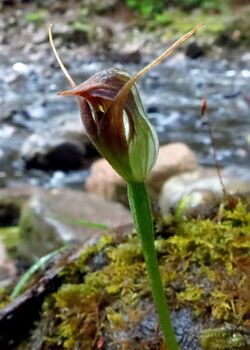Biology:Pterostylis pedunculata
| Maroonhood | |
|---|---|

| |
| Pterostylis erecta growing in the Tarkine | |
| Scientific classification | |
| Kingdom: | Plantae |
| Clade: | Tracheophytes |
| Clade: | Angiosperms |
| Clade: | Monocots |
| Order: | Asparagales |
| Family: | Orchidaceae |
| Subfamily: | Orchidoideae |
| Tribe: | Cranichideae |
| Genus: | Pterostylis |
| Species: | P. pedunculata
|
| Binomial name | |
| Pterostylis pedunculata R.Br.[1]
| |
Pterostylis pedunculata, commonly known as the upright maroonhood, is a species of orchid endemic to south-eastern Australia . Flowering plants have a rosette of two to six stalked leaves and a single green flower which is white near its base and tinged with reddish brown to black and with a gap between the petals and lateral sepals. It is common and widespread in a range of habitats.
Description
Pterostylis pedunculata is a terrestrial, perennial, deciduous, herb with an underground tuber. Flowering plants have a rosette of between two and six stalked leaves, each leaf 10–65 mm long and 5–20 mm wide. A single flower 15–20 mm long and 5–7 mm wide is borne on a spike 60–250 mm high. The flowers are green, white near the base with reddish-brown to black tinges near the tip. The dorsal sepal and petals are fused, forming a hood or "galea" over the column but the dorsal sepal is slightly longer than the petals and has a sharp point on its end. There is a gap between the petals and the lateral sepals, which have thread-like tips 16–30 mm long. The sinus between the lateral sepals has a deep, V-shaped notch in the centre. The labellum is 5–7 mm long, about 3 mm wide, reddish-brown, egg-shaped, straight and just visible above the sinus. Flowering occurs from July to November.[2][3][4][5]
Taxonomy and naming
Pterostylis pedunculata was first formally described in 1810 by Robert Brown and the description was published in the Prodromus Florae Novae Hollandiae et Insulae Van Diemen.[1][6] The specific epithet (pedunculata) is a Latin word meaning "small, slender stalk".[7]
Distribution and habitat
The maroonhood is widespread and common in moist, sheltered places in forest but also grows in coastal scrub. It is found from south-eastern Queensland to south-eastern South Australia and to Tasmania. In New South Wales it mostly occurs in coastal and near-coastal districts but extends as far inland as the Australian Capital Territory.[2][3][4][5][8]
References
- ↑ 1.0 1.1 "Pterostylis pedunculata". APNI. https://id.biodiversity.org.au/instance/apni/488213. Retrieved 24 May 2017.
- ↑ 2.0 2.1 Jones, David L. (2006). A complete guide to native orchids of Australia including the island territories. Frenchs Forest, N.S.W.: New Holland. p. 302. ISBN 978-1877069123.
- ↑ 3.0 3.1 Jones, David L.. "Pterostylis pedunculata". Royal Botanic Garden Sydney: plantnet. http://plantnet.rbgsyd.nsw.gov.au/cgi-bin/NSWfl.pl?page=nswfl&lvl=sp&name=Pterostylis~pedunculata. Retrieved 24 May 2017.
- ↑ 4.0 4.1 Jeanes, Jeff. "Pterostylis pedunculata". Royal Botanic Gardens Victoria: vicflora. https://vicflora.rbg.vic.gov.au/flora/taxon/5db59e42-c0b3-4cb6-aeed-14d4a30c92c5. Retrieved 24 May 2017.
- ↑ 5.0 5.1 "Pterostylis pedunculata". State Herbarium of South Australia: eflora SA. http://www.flora.sa.gov.au/cgi-bin/speciesfacts_display.cgi?form=speciesfacts&family=&genus=Pterostylis&species=pedunculata&iname=&submit=Display. Retrieved 24 May 2017.
- ↑ Brown, Robert (1810). Prodromus Florae Novae Hollandiae et Insulae Van Diemen. London. p. 327. https://www.biodiversitylibrary.org/item/21871#page/195/mode/1up. Retrieved 22 May 2017.
- ↑ Brown, Roland Wilbur (1956). The Composition of Scientific Words. Washington, D.C.: Smithsonian Institution Press. p. 751.
- ↑ Jones, David L. (1998). "Contributions to Tasmanian Orchidology". Australian Orchid Research 3: 148–149.
Wikidata ☰ Q15492189 entry
 |

